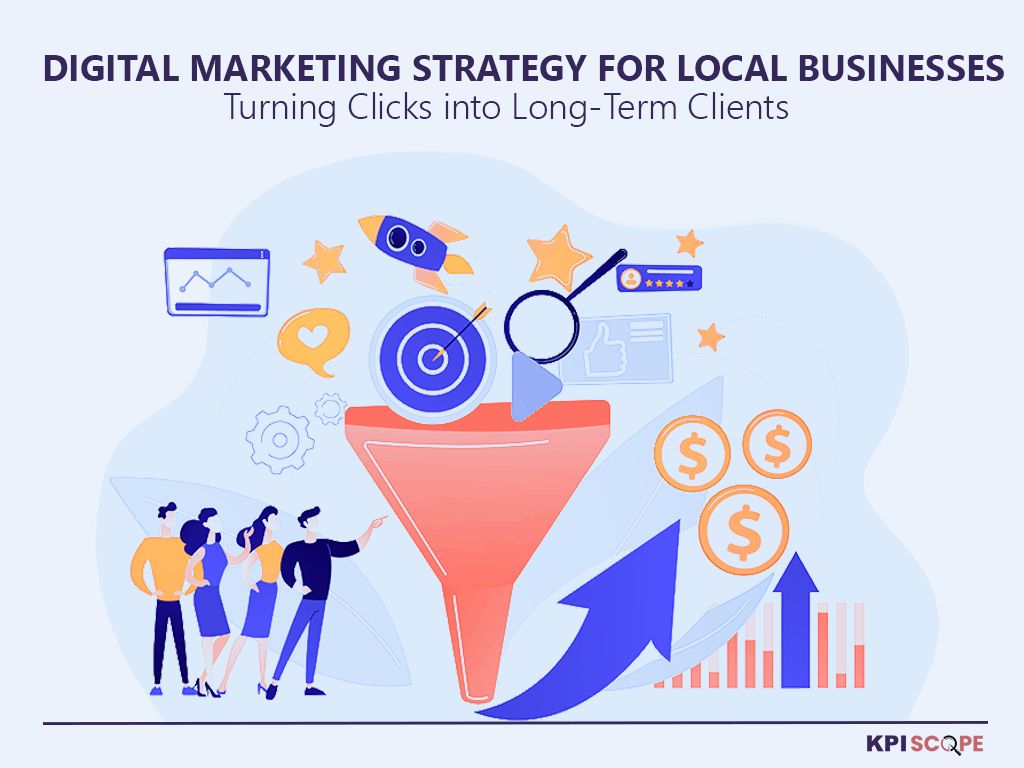A powerful digital marketing strategy for local businesses can transform your online presence. It turns clicks into conversations and prospects into long-term clients.
This guide provides a detailed roadmap for building that strategy. We will explore every stage of your client’s journey. Then, we will identify the most effective channels. Finally, we will show you how to measure your success.
The Foundation: Your Client’s Journey
The path from a potential client to a loyal advocate is not a straight line. It is a journey with different stages. We can simplify this process into three core phases: Awareness, Consideration, and Conversion. We will also add a fourth, crucial stage: Loyalty. A smart strategy must address all of them.
Awareness Stage: Capturing Their Attention
At this initial stage, a potential client becomes aware of a problem. They are not yet looking for a specific solution from a specific firm. Your task is to get in front of them and educate them. You want to introduce your brand to them for the first time. The goal is to show them what you have to offer and position yourself as a helpful resource. This is often the first touchpoint. This is where your potential for acquiring new customers is highest.
Consideration Stage: Earning Their Trust
Once a prospect is aware of their problem, they start looking for solutions. They are researching options and comparing different providers. They are evaluating your expertise and capabilities. Your job in this stage is to prove your value.
You must build trust and set your brand apart from the competition. This is where a prospect learns about your firm’s values. They are looking for a reliable solution.
Conversion Stage: Turning Prospects into Clients
A prospect is now ready to make a decision. They have done their research. They have narrowed down their options. You must now give them a clear reason to choose your firm. This is the final stage before they become a customer. Your content and calls to action must eliminate any final doubts. You want to make it as easy as possible for them to take action.
Depending on the nature of the your business, this may take months of nurturing. You must provide an easy opportunity to hire you.
Beyond Conversion: Nurturing Loyalty and Advocacy
The client’s journey does not end with a single transaction. Keeping existing clients is more cost-effective than finding new ones. Your goal is to turn one-time clients into repeat customers and, eventually, into brand advocates.
These advocates will recommend your services to others. They become an extension of your sales team. This is a powerful, organic form of growth. A successful strategy must focus on this stage.
The Funnel Is a Loop, Not a Line
The traditional marketing funnel is a linear progression. You attract a wide audience at the top and convert a smaller group at the bottom. But the journey is not always linear. A client may enter your funnel at any stage. A prospect searching for a “tax attorney near me” is already in the conversion stage. They have a problem and are ready to hire you.
Similarly, a client who becomes a brand advocate provides referrals. These referrals feed back into the awareness stage for new prospects. This creates a continuous loop. Your strategy must be ready to capture prospects at any point. You need to provide content for all of these stages. This ensures you cover all your bases and maximize every opportunity.
Your Digital Marketing Toolkit: Key Channels by Funnel Stage
This table provides a high-level overview of the most effective channels. It also links them to each stage of the funnel. You can use it as a checklist and a reference guide.
| Funnel Stage | Primary Channels | Key Content & Tactics |
| Awareness | Google Business Profile, Local SEO, Content Marketing, Paid Ads, Social Media | Complete listings, keyword-rich blog posts, helpful videos, targeted PPC ads |
| Consideration | Reputation Management, Website Content, Email Marketing, Social Media | Online reviews, case studies, webinars, newsletters, retargeting ads |
| Conversion | Optimized Website, Paid Ads, Email Marketing | Clear calls to action, testimonials, product/service pages, retargeting ads |
| Loyalty & Advocacy | Email Marketing, Social Media, Reputation Management | Customer service, feedback loops, review requests, referral programs |
The Awareness Stage: Getting Found
Your goal is to become visible. You want to reach potential clients who are looking for a solution. You can do this through several key channels.
Your Google Business Profile: Your Local Cornerstone
Your Google Business Profile (GBP) is your single most important asset. It is a game-changer for local professional services. It is often the first place a client interacts with you. Claim and verify your profile immediately. Make sure it is complete and accurate. Include your name, address, phone number, and hours. Use clear, keyword-rich descriptions of your services.
Use your GBP as an engagement tool. Share updates or promotions with Google Posts. Populate the Q&A section with common questions. Manage your reviews effectively. Reply to feedback within a day. Don’t forget to create a profile on Bing Places and Apple Business Connect as well.
Local SEO: Appearing in Local Search
Local SEO is the process of optimizing your presence for location-specific searches. This is a core part of any successful digital marketing strategy for local businesses. It helps search engines understand where your business is located. You can optimize your content for city- or neighborhood-based keywords.
Ensure your Name, Address, and Phone number (NAP) are consistent across your website and all your local listings. You can also write location-specific pages. This sends a stronger signal to search engines. It increases your chances of ranking higher in local search results.
Content Marketing: Becoming a Trusted Authority
Content is the heart of your strategy. It is how you communicate your expertise. It builds trust and shows potential clients how you can help them. Focus on answering the questions your clients are already asking. You want to provide useful, relevant information.
Publish blog posts and case studies. Create videos and host webinars. You can write about common tax issues or legal changes, for example. Make it all about helping, not selling.
Paid Ads: Reaching Your Ideal Client Instantly
Paid advertising helps you capture customers who are actively looking for your services. These ads are more targeted than traditional marketing. You get more for your marketing budget.
You can use Google Search Ads (PPC) and retargeting ads. Retargeting shows ads to people who have already visited your website. It is a way to stay top-of-mind. You can also use paid promotions on social media platforms like Meta (Instatgram, Facebook, WhatsApp), Tik Tok or YouTube.
The Consideration Stage: Proving Your Value
Once a prospect knows about you, you must earn their trust. This is the moment to showcase your credibility. Your content must provide a deeper level of value.
Reputation Management: Showcasing Social Proof
Online reviews are vital for attracting local attention. Consumers trust companies with ratings of 4 stars or higher. Managing reviews shows you care about your clients.
You should have a structured approach to reviews. Ask for reviews within 24-48 hours after a service. Respond to all reviews, both positive and negative. You can also showcase these testimonials on your website and social media. This provides powerful social proof.
High-Value Content: The Power of Case Studies and Webinars
Your content for this stage should be more specific. It should go beyond general advice. Case studies and webinars are perfect examples of this.
A case study tells a story about a client’s challenges. It shows how your firm provided a solution. A webinar allows you to showcase your expertise directly to a live audience. You can host a webinar on topics your target audience cares about.
Email Marketing: Nurturing the Relationship
Email marketing is one of the most effective techniques for professional services. It is a great way to stay in touch. Use a simple form on your website to collect email addresses. You can then send out regular updates or helpful tips. Set up automated drip campaigns to nurture leads based on their behavior.
The Conversion Stage: Sealing the Deal
At this final stage, you must make it easy for a client to choose you. Your website and marketing materials must provide clear direction.
Optimized Website: The Ultimate Conversion Engine
Your website is a crucial part of the sales process. It is a secondary store location. It must have a clear description of your services, contact information, and testimonials. Include clear calls to action (CTAs) that encourage the user to take the next step. A high-performance website for law firms, for example, converts at a rate of 4% or higher. You want to build a website that generates leads.
The Dual Roles of Channels
A successful strategy recognizes that channels can serve multiple purposes. A single platform can engage clients at different stages.
For example, your Google Business Profile is a classic tool for awareness. It helps people find you locally. However, it also includes a “call” or “website” link. This makes it a direct conversion channel.
Similarly, a client testimonial on your website is social proof. It helps a prospect in the consideration stage. It can also be the final push that leads to a conversion. A well-executed digital marketing strategy for local businesses uses channels in a multi-faceted way. The content you create for a channel determines its role.
Combining Online and Traditional Marketing
You don’t have to choose between online and traditional marketing. Combining them can boost your reach and engagement. This creates a seamless customer experience across all touchpoints.
Consistency Is Key: Unified Branding Across All Channels
Your brand must be consistent everywhere. Your logo, color palette, and key messages should be uniform. This includes your website, business cards, social media profiles, and print materials. This consistency builds brand recall and trust. It prevents mixed messages. Your high-level strategy should be the same in both the digital and offline worlds.
Digital-to-Offline: Driving Foot Traffic and Engagement
Use your digital channels to drive real-world action. You can use your social media to promote an in-person event or a workshop. Showcase your online customer reviews in your physical office. You can also offer in-person consultations that clients can book online. This solidifies relationships and provides a personal touch.
Offline-to-Digital: Leveraging Traditional Efforts for Online Growth
The reverse is also true. You can use traditional marketing to build your online presence. You can include calls to action on your flyers and brochures. This encourages customers to follow you on LinkedIn or Instagram.
The Comeback of QR Codes
QR codes have made a major comeback. They are a simple way to connect your offline and online marketing efforts. Add a QR code to your business cards or print ads. You can link it to a specific landing page with a special offer or a client testimonial video. This allows you to track engagement from your traditional campaigns.
Trackable Links and Phone Numbers
Personalized URLs (PURLs) and custom phone numbers are great tools. They help you measure the success of offline campaigns. For example, you can use a unique URL in a print ad. This shows you exactly how many website visits came from that campaign. These unique identifiers provide data that refines your marketing strategy.
The Symbiotic Relationship of Data
Online and traditional marketing have a symbiotic relationship. It is not just about tracking. Digital data can also inform and improve traditional strategies. By analyzing online search trends, you can decide which zip codes to target with a direct mail campaign. This integration makes both channels more efficient and effective.
The Engine Room: Your Guide to Strategic SEO and Readability
A great strategy requires a solid technical foundation. This means understanding on-page SEO. It also means writing content that is easy to read and understand.
Mastering On-Page SEO: Beyond the Basics
SEO is not about tricking an algorithm, It is about genuinely becoming a valuable resource for your audience. It is about building trust with your prospects and with search engines.
Finding Your Long-Tail Keywords
Long-tail keywords are specific, multi-word phrases. They are less competitive than broad terms. They target users with high purchase intent. Use Google’s autocomplete function to find ideas. Look for questions on communities like Reddit and Quora. You can also use tools like Semrush to find low-volume, low-competition terms.
Placing Keywords for Maximum Impact
Once you have your keywords, you must use them correctly. Place your primary keyword in your title tag, meta description, and URL. Include variations in your headings (H1, H2, etc.). Naturally spread your keywords throughout your content. Always prioritize natural language over stuffing keywords.
Building Topical Authority
Google wants to see you as a trusted expert in your field. This is called topical authority. You build this by creating high-quality content that covers a subject in depth. You should write about a main keyword and all its related terms. Link to other helpful resources on your site. This signals your expertise to Google and to your readers.
The Art of Readability: Writing for a Modern Audience
Online readers scan content. They are often in a hurry. You must make your content easy to digest.
Short Sentences, Short Paragraphs
Keep your sentences short. Aim for no more than 25 words. Keep your paragraphs short as well. Each paragraph should cover one main idea. Do not be afraid of the return key. Short paragraphs are easier for readers to scan. They also look less intimidating on a mobile device.
Speaking Directly to Your Reader
Use a knowledgeable yet friendly tone. You want to sound like a trusted expert. Address your reader directly using “you.” This creates a personal connection. Use an active voice to create clarity and confidence. This makes your content easier to read. It also helps with message retention. Avoid jargon and overly technical words that your audience may not understand.
SEO Is a Trust Metric
The goal of modern SEO is not about technical manipulation. It is about building trust. Google’s algorithm is designed to reward expertise and trustworthiness. By answering a user’s precise questions with high-quality content, you signal your authority. This trust, in turn, leads to higher rankings. It brings in more qualified traffic. A great digital marketing strategy for local businesses is one that is built on trust.
Conclusion: Your Next Steps
Building a powerful digital marketing strategy for local businesses is a continuous process. You must build a strong foundation and use a full-funnel approach.
Integrating your online and traditional efforts will become a 360 strategy to position your brand top of mind for your target audience.
Last but not least, to know if your efforts are working, you must measure them. Metrics are how you connect your marketing efforts to your business goals and allows you to make smarter decisions. You can prove your return on investment. You can ensure every dollar you spend helps you grow your business.


